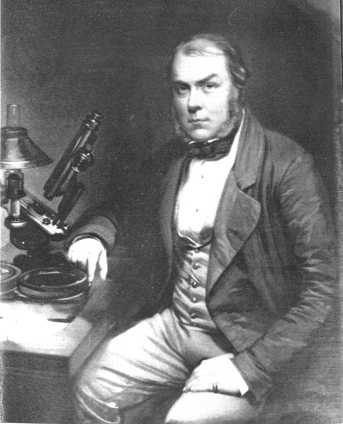John Thomas Quekett
John Thomas Quekett (1815–1861) was a prominent British microscopist and histologist, renowned for his significant contributions to the development of microscopy and its application in the field of biology. His work laid foundational knowledge for the fields of cell biology and histology, making substantial impacts on the scientific understanding of tissue structure and function.
Early Life and Education[edit | edit source]
John Thomas Quekett was born on August 11, 1815, in Langport, Somerset, England. He was the third son in a family with a strong interest in natural history. His education began under the guidance of his father, who was a schoolmaster, fostering an early interest in the natural sciences. Quekett later attended University College London, where he studied under renowned figures such as Robert Edmond Grant, furthering his interest in microscopy and the study of microscopic life.
Career and Contributions[edit | edit source]
In 1839, Quekett was appointed as an assistant to Richard Owen, a leading anatomist and paleontologist, at the Hunterian Museum of the Royal College of Surgeons in England. This position allowed him to refine his skills in microscopic preparation and analysis, contributing significantly to the museum's collection.
Quekett's most notable work, "A Practical Treatise on the Use of the Microscope," published in 1848, became a seminal text in the field of microscopy. It provided detailed instructions on microscope use, specimen preparation, and the study of histological samples, making microscopy accessible to a wider audience of scientists and enthusiasts.
Throughout his career, Quekett published extensively on the structure and function of animal tissues, making pioneering contributions to the understanding of muscle tissue, bone structure, and the development of teeth. His research on the microscopic structure of wood also laid the groundwork for the field of dendrochronology.
Legacy[edit | edit source]
John Thomas Quekett's dedication to microscopy and histology significantly advanced these fields. He was instrumental in the establishment of the Quekett Microscopical Club in 1865, which continues to promote interest in microscopy. Quekett's extensive collection of microscopes and histological specimens was bequeathed to the Royal College of Surgeons, where it remains an invaluable resource for researchers.
Quekett died on August 20, 1861, but his legacy lives on through his contributions to science and the institutions that continue to honor his work. His efforts in improving microscope technology and technique have had a lasting impact on the biological sciences, enabling future generations of scientists to explore the microscopic world with greater clarity and understanding.
Navigation: Wellness - Encyclopedia - Health topics - Disease Index - Drugs - World Directory - Gray's Anatomy - Keto diet - Recipes
Search WikiMD
Ad.Tired of being Overweight? Try W8MD's physician weight loss program.
Semaglutide (Ozempic / Wegovy and Tirzepatide (Mounjaro) available.
Advertise on WikiMD
WikiMD is not a substitute for professional medical advice. See full disclaimer.
Credits:Most images are courtesy of Wikimedia commons, and templates Wikipedia, licensed under CC BY SA or similar.
Contributors: Prab R. Tumpati, MD

